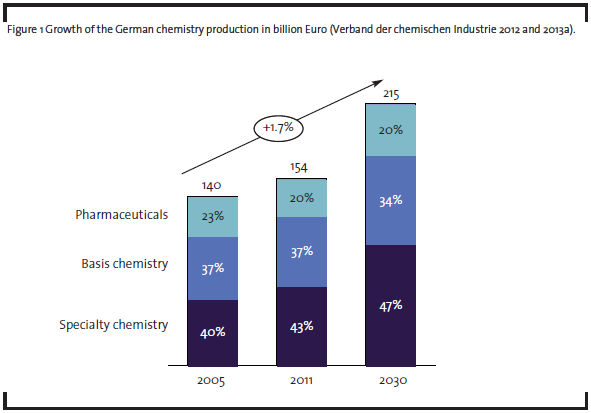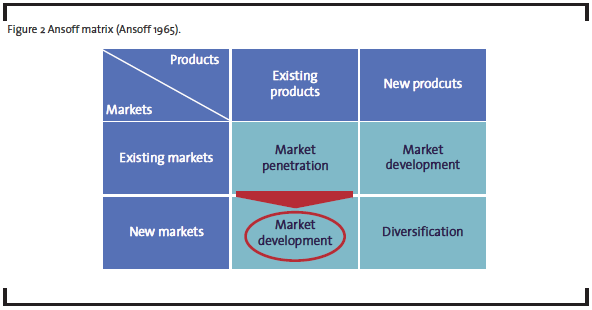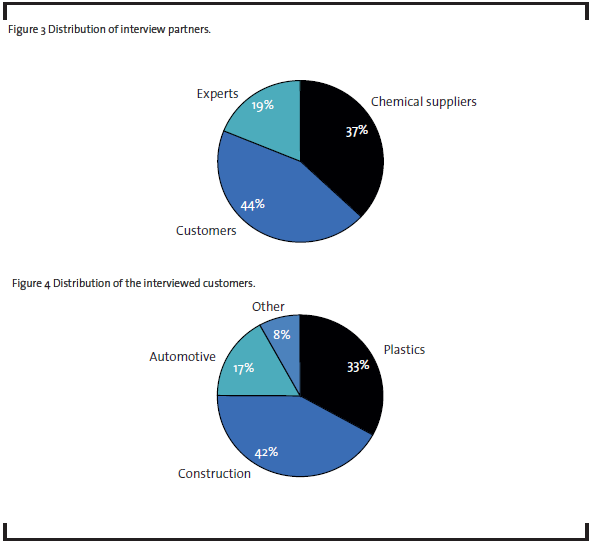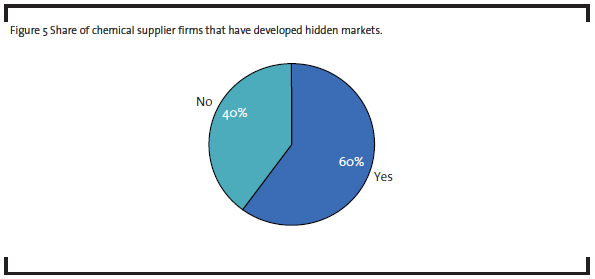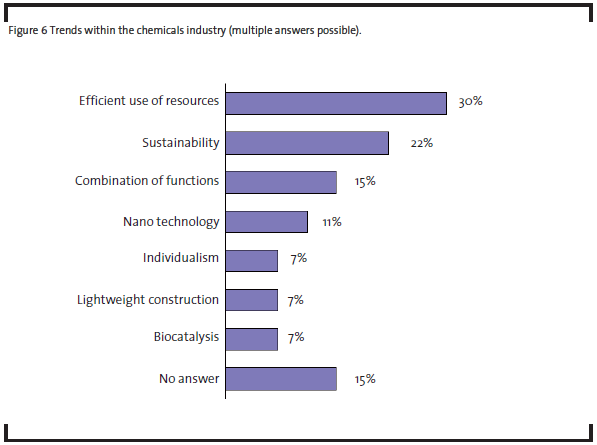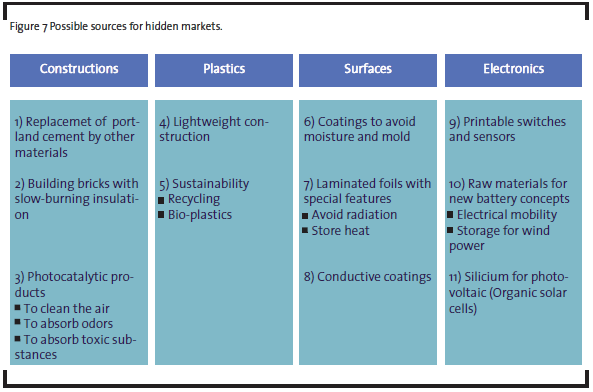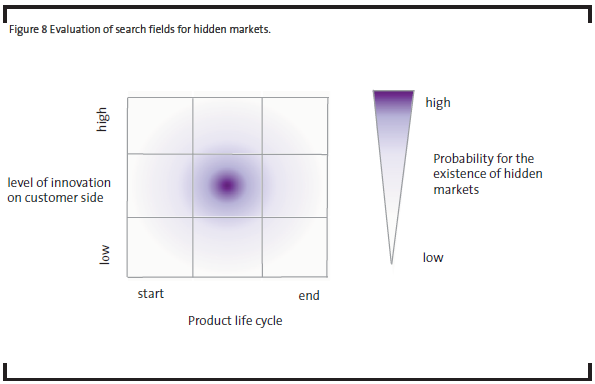Hidden Markets in the Chemical Industry – Illusion or Growth Opportunity?
1 Introduction
The chemical-pharmaceutical industry in Germany plays an important role. With its many different products, the industry stands at the beginning of a long supply chain. Over the last number of decades, the high innovation rate has contributed to high growth rates in Germany, even though the market was saturated. The chemical industry in Germany is a driver for technology and innovation – even more so than mechanical engineering. Many downstream branches depend on ideas from the chemical industry, which accounts for 17% of all industry R&D spendings (Kellermann 2012). Besides innovation, the German chemical industry is known for its success abroad. Most firms sell their products in Europe, and often further afield, too. Germany is responsible for 25% of the total sales of chemical products in Europe. In total, more than half of sales are generated abroad (Verband der chemischen Industrie 2013a). To stand out in emerging markets like Asia and South America, risks must be taken into account, especially for small and medium sized firms. It is this kind of firm that is dominating the chemical industry in Germany.
Based on the dynamically changing nature of markets, other sources for growth exist besides innovation and foreign expansion. One can assume that existing products with a formerly defined purpose can also be used in different areas. Ideally no modifications will have to be made to the product. We call these kinds of market opportunities “hidden markets.” Product developments that normally require more resources are not the focus of this paper. Most interesting should be these niche markets for firms that supply chemical products to downstream branches outside the chemical industry.
However, the existence of hidden markets in the chemical industry is still doubted and sometimes seen as an illusion. We investigate whether hidden markets are only an illusion or if they really do exist. If we can proof their existence, we want to go on to focus on two questions:
1) What are interesting and upcoming fields where chemical firms could generate additional sales?
2) What are the success factors to develop and exploit hidden markets?
2 The German chemical and pharmaceutical industry in detail
With its large variety of products, the chemical industry can be seen as very heterogeneous. Furthermore, its long supply chain and the fact that it accounts for 11% of total sales of the manufacturing industry in Germany also contribute to this perception. Behind the automotive and mechanical engineering industries, the chemical industry is ranked in third place. One of the strengths of the German chemical industry is the strong partnerships between large multinational enterprises and small firms, along with the fragmentation across basic chemistry (37%), pharmaceuticals (20%) and specialty chemistry (43%). The largest block, specialty chemistry, includes colors, pesticides and plastics, among other things. It is estimated that the focus on specialty chemicals will strengthen in the future. This development is, for example, driven by lightweight construction in the automobile industry (Verband der chemischen Industrie 2013a).
3 A difficult business in the domestic market
The growth of the chemical industry in Germany has been strongly driven by innovations which have profited downstream industries immensely. Nonetheless, the power of the chemical industry as the driving force for innovations in Germany declined from 1995 to 2005. In 1995, the chemical industry accounted for 20% of interbranch inputs, and in 2005 it was only 15% (Gehrke and Rammer 2011). As a result of the global financial crisis, domestic sales declined and have not yet reached the maximum that had been reached prior to the crisis. While sales rose by 6% in 2011, they dropped by 2.5% in 2012, and by 1% in the first half of 2013. Chemical production in Germany in 2012 is still 3% lower than the pre-crisis level, and not including pharmaceutical production it is still 6% lower (Verband der chemischen Industrie 2013b). If any growth in the domestic market is possible it is estimated to be small and limited. Large, multinational chemistry firms from Germany like Altana, BASF, Evonik and Lanxess all reported declining sales between 3% and 10% for their home market in the first half of the year 2013. This situation is tightened by the rise of raw material prices, so the firms try to compensate the weak results in Germany with their traditionally strong business abroad.
4 Business abroad is risky, too
Strong export business and high sales figures from abroad show the dependency of German chemical firms. In 2013, around 85% of small- and medium-sized firms (with more than 2.5m sales per year) are active abroad. In 2007, the share was only 80% (Commerzbank 2013). Primarily, the firms started their foreign business in Europe. Currently, the situation is not as promising as a few years ago. Economic activity in Europe is weak and its debt crisis is affecting the German chemical industry immensely. The firms also have to expect an unsteady demand in Europe, especially in the southern part of the continent. With time the chemical firms enlarged their efforts step by step into the direction of outside European markets. The strong growth in Asia and South America has justified the focus on business abroad and helped to balance the variations in Germany. But today, growth rates in China are declining and only moderate growth is expected in the USA. In the short- and mediumterm, no changes can be anticipated.
However, further risks come along with conducting business abroad. For example, currency risks, the lack of legal security, trade barriers and the protection of intellectual property can be problematic in the context of international sales (Commerzbank 2013). Jürgen Heraeus, Chairman of the Asia-Pacific committee of the German economy, even warns small- and medium-sized firms that they should only make their way to China if enough resources can be raised. Besides capital, time, qualified employees and a strong network are necessary for the development of new customers and markets (Oldenkop 2012).
5 The development of hidden markets
German chemistry firms have to face challenges in their domestic as well as in foreign markets. To generate growth, or rather compensate shrinking sales, other methods should be taken into account. Here, the development of so called hidden markets can help. With a systematic approach, additional sales can be generated outside of known branches with existing products and technologies. Maybe the products need to be modified slightly, but expensive developments for new products are avoided. The focus lies on industrial customers outside of the chemistry branch. This development of new markets, e.g. selling existing products to consumers outside of known branches, is called market development (Ansoff 1965).
However, new customers do not necessarily need to come from new branches. It is possible that a product can also be used within the same branch for another application by other customers.
6 Methodology
6.1 Research questions
At the beginning, one has to raise the question if hidden markets in the chemical industry really exist or if they are only an illusion. Examples for the use of products in an application field which was not the original purpose can be found from time to time. It is well known that Viagra was originally developed as a medical treatment against cardiac insufficiency. Today it is a blockbuster drug against erectile dysfunctions. However, how firms could identify new fields of application for their existing products and if adequate sales can be generated in these markets has not yet been analyzed. We want to focus on the chemical industry and raise the following questions:
- Have chemistry firms found new fields of application and customers for their existing products?
- What trends affect the chemical industry?
- What fields of application may be of interest to chemistry firms in the future?
- What are critical success factors and requirements for the development of hidden markets?
6.2 Design of the study
The empirical part of the study relies on interviews. We wanted to identify real world examples for the exploitation of hidden markets and the explicit success factors. Outlined topics included the emergence of today’s business, possible examples and success factors for the development of hidden markets, as well as current trends that may affect business in the future. Three different groups of interest were contacted. Firstly, decision makers from chemical supply firms, like the CEO or the head of new business development or product management. Secondly, we contacted the CEOs or head of research and development on the customer side. And thirdly, we arranged interviews with experts in the chemical industry or on the customer side from research institutions or consultancy firms. The interviews were conducted personally or via telephone during April and July 2013 and lasted for around 30 minutes.
6.3 Conducted interviews
In total, 27 interviews were conducted; 11 interviews were carried out with representatives of chemical firms1 and 11 with customers from outside the chemical industry. The enterprises all have a location in Germany, but are also active internationally. The firms are independent or part of a larger corporate group. The average sales in 2012 were 181m Euro (median) and 840 people were employed on average (median)2.
1Two interviews were conducted with one firm.
2To avoid a shift due to outliers, we report the median.
6.4 Results
Some interviewees doubted the existence of hidden markets because they had not been successful in generating additional sales in other branches. Consequently, fields of application outside the served markets are not seen as feasible. Furthermore, they believe that if hidden markets exist, only large corporations with enough financial resources and determined divisions focusing on new business development could exploit these niches. But this opinion was only held by the minority of our interview partners. In fact, the existence of hidden markets with a potential for products that were originally designed for other industries was confirmed. Six out of ten chemical suppliers could outline examples in which they developed new markets with existing products, what exactly matches our definition of hidden markets. The stagnation in markets even forces chemistry firms to develop new markets and customers. The difficulty is the lack of information and sometimes the need to modify the business model.
6.5 Trends which will affect the chemical industry
The chemical industry is a very heterogeneous branch with many different products. Nevertheless, there are trends that affect all players in the industry. Thus, greater trends should be identified in a first step.
For the future an efficient use of resources is becoming more and more important. For example, the chemical industry needs to supply products which help to treat and purify water, and material for better insulation to save energy. Especially the field of renewable energies shows certain potential. Here, solutions that increase the degree of efficiency for wind or solar power plants are very important. Moreover, in order to use today’s resources in a more efficient way, abrasion needs to be avoided.
Sustainability was the second most common answer. This includes topics like the protection of the environment, as well as the use of emission and toxic free materials. If the chemical industry can provide solutions for an efficient and sustainable use of resources, large sales can be generated.
Another trend that is seen as important and as a driving force for further growth is the combination of functions, e.g. with only one product results can be achieved where previously two products were needed. This helps to simplify processes and consequently costs are reduced. For example, lubricants that can be used for cooling during the drilling process and at the same time it lubricates the gear are available today. In the past, two different products would have been needed. Many other applications are imaginable. In the last years, many new products have been developed that could substitute previous solutions with completely different approaches, e.g. in mechanical engineering where chemical solutions have not been considered so far. Further trends are the use of nanotechnology, the desire for individualism, lightweight constructions and biocatalysis.
To focus on the most promising ideas for hidden markets, firms should try to establish a link between these trends and their current product portfolio. This helps to concentrate on areas where interesting sales are possible. Otherwise a firm finds a market for its products outside served branches, but the niche is just too small and has no potential.
6.6 Future markets for the chemical industry
To develop hidden markets and sell existing products to customers outside served industries, one has to identify these niches. The described trends show a first direction. With these trends a certain dynamic comes along in the chemical industry as well as in downstream branches. With this dynamic, common structures within an industry can be scrutinized and other solutions can substitute current ones. To immerge into more details, fields of application for possible hidden markets are derived. The results are 11 fields that can be clustered into 4 areas: the construction industry, plastics, surfaces and electronics.
The construction industry shows weak growth rates in Europe and Germany. Nevertheless, a new mindset with unconventional solutions offers possibilities.
- One of the most important materials within the construction industry is concrete that requires cement. Although concrete has a long history, radical innovations for concrete have been made. Today, concrete is used in numerous fields including civil engineering and highbuilding as well as tunnel and bridge constructions. Special concrete is even used for drilling applications. To save resources, the use of alternative materials that exist in large amounts has increased in the manufacturing process of concrete. One of the alternative materials used is blast-furnace slag. In the long run, portland cement will be replaced by other binding materials.
- To save costly energy for heating and cooling, consumers put more and more emphasis on insulation systems. Solutions that combine an effective insulation into brickwork are favored at the moment. Another requirement is fireproofing. Current systems that use polystyrene fail mostly on this last point.
- For the interior fitting, customers place an emphasis on solutions that provide clean and pure air. A photo catalytic approach for the absorption of bad smells or toxic air already exists today and is realized by wall paint. With the help of light, contaminated substances are decomposed into neutral substances. This new kind of wall paint is indeed a product innovation, but it requires common materials like catalysts. The result is not only achievable by using wall paint, but also other construction materials like carpets or wall parts. For a catalyst producer, this application is definitely an interesting opportunity. Coming to the field of plastics, a sales growth is projected for the global plastics industry, especially in Asia. A high number of different material properties offer a wide range of applications, for example, for components in the automobile industry, in electronics or even in the construction industry. Therefore, plastics can be classified as a reasonable search field for hidden markets.
- Since lightweight constructions show a high demand, design engineers often use plastics. But plastic does not outperform glass or metal in all ways. That is why engineers expect further improvements in product performance from the plastics industry.
- Another important topic for the plastics industry is sustainability with the drivers recycling and bio-plastics. For the latter, one has to differentiate between the functionality, e.g. the plastic is biodegradable, and the raw material basis, e.g. the raw material comes from renewable material. Until 2020, estimations project a share of 20% for bio-plastics from the global plastic production. The most important bio polymers are polylactides (PLA). Besides the construction and plastics industry, our interview partners classified the field of surfaces as a promising market in the future. Different fields of applications were drafted, in which growing sales can be expected. In each case, functions integrated onto surfaces are becoming more and more important.
- Coating and painting can be used to reduce moisture and avoid mold. Fields of application include kitchens, swimming pools or boats. Aside from this, normal buildings are also increasingly better insulated, so the natural ventilation that promotes the creation of mold is reduced. To achieve this function today, first products hit the market where nanoparticles are added to paintings.
- Beside coating and painting, foils are attracting engineers and even end customers. This trend can be noticed on the streets where the original coating of cars is laminated with foils. This protects the coating and is cheaper than recoating the whole car in another color. Apart from aesthetic reasons, functional features can also be realized with foils. They can help to prevent radiation from windows or to store heat in floors. In the field of solar technology, transparent foils could replace expensive panels made out of glass.
- Combining surface technology with electronics, two interview partners drafted the promising field of conductive coatings. Cables and printed circuits could become obsolete. If these coatings and particles are transparent they could even be applied on displays or other surfaces to achieve completely new features.
- As the fourth area, electronics as a customer of the chemical industry is forecasted a strong future. Printable switches are an often-discussed topic. However, further research is needed before end products will be available on the market.
- In addition, the chemical industry must not neglect the large opportunities arising from electrical mobility and solar technology. The performance of batteries has to be improved so that electrical mobility can become interesting for the majority. Firms are working on new battery concepts that provide higher capacities and a growing demand for relevant raw materials supplied by the chemical industry can be expected.
- Within the photovoltaic field, development goes into the direction of organic solar cells. Their basis is carbon compounds, e.g. plastics. Today the effectiveness of these cells is still too low. But, especially for suppliers of the plastics industry, this field may become very interesting.
The identified future markets illustrate high growth rates for suppliers from the chemical industry3. Even if the mentioned applications only represent niches in the beginning, the expected growth can bear an interesting potential for chemical suppliers.
3The results are not representative for the whole German industry. That is why additional fields for hidden markets are imaginable.
6.7 Successful examples for the development of hidden markets
Until now, we have considered trends and fields of application where growing sales can be expected in the future. Now we want to show, with examples, that chemical firms can indeed develop new businesses outside their served branches.
6.7.1 Example 1: Pigments from the color industry for new functions
The first example comes from a supplier for color pigments that are used in the coating and painting industry. These pigments give a shiny brilliance to the coating because of small particles of metal (like silver, copper or aluminum). These coatings are often used by the automobile industry, especially for the color silver. Since the demand for that color has declined, sales of the pigments have dropped, too. A certain pressure for the pigments manufacturer emerged. Since the demand from other customers also declined, new markets should be developed. The pigments manufacturer followed a technology-push approach since he had the technology and searched for further fields of application. To keep costs low, the focus lies on existing products or technologies, e.g. the effect pigments. And these pigments offer additional features beside the optical one. They are conductive for electrical power and show a high resistance to abrasion. The firm was able to find new customers. The new coating manufacturer was still in the same branch as already served customers. But that firm focused more on coatings with functions instead of on the aesthetics. A completely new customer from a completely new industry was a manufacturer for technical textiles. The pigments are integrated into the clothes to achieve a high resistance of abrasion and heat. This new kind of cloth is used by firefighters, for example. He estimates the sales potential by the hidden markets at around 10% of his current sales.
6.7.2 Example 2: From the construction industry into the tire industry
In our second example, the firm manufactures polycarboxylate ether (PCE) that is used for the production of concrete. The material helps to extract water from liquid concrete, and is also interesting for other products. For example, a tire manufacturer who is today using PCE polymers in his production process was interested. Unfortunately the supplier does not know exactly how his material is being used at the customer’s site. This is also the reason why the supplier did not find this hidden market before he was contacted by the tire manufacturer. This is a good example of how an existing product can also be used in a completely different industry.
6.7.3 Example 3: From decking to pencils
The third example was reported by a firm that is manufacturing additives for the plastics industry. In the last few years, the interest for wood plastic composites (WPC) has increased. WPC consists of plastic (PVC) and an organic material like wood dust. A typical application for WPC is decking that was previously made of wood. To supply more additives for WPC, more places where WPC could be used were needed; this is why the supplier started cooperation with a stationary manufacturer, whose pencils had previously been made of wood. The goal of this cooperation was to extrude pencils with the material WPC. Some adaptions for the WPC composition had to be made. The supplier still needs to supply its additives. Beside customers from the plastic industry focusing on decking or other construction materials, he now also supplies a stationary manufacturer. This example shows how a new market was developed where an existing product became obsolete (i.e. wood vs. WPC for pencils). However, sales with additives are now possible not only to the customers extruding deckings, but also with a stationary manufacturer.
6.7.4 Example 4: From gravure to digital printing
Our forth example comes from printing ink branch. In former days our interview partner produced additives and surfactants for ink that have been used for gravure printing. But the technological development moved further that the digital printing technology made gravure printing obsolete. The firm realized that surfactants are also needed for the ink of laser printers although the printing technologies are totally different. The supplied product is still the same, but only the customers are new.
7 Managerial implications
We now conclude and generalize the success factors to give advice for chemical firms that are interested in the development of hidden markets.
First of all, the overall strategy, in combination with the firm’s culture, must make it possible to enter niches and developing markets that lie outside previous branches. The top management must clearly communicate the needs and goals when searching for hidden markets. Employees must understand the potential of hidden markets and their exploitation can be easier than new product development or selling products in foreign countries.
In the above case, two approaches were followed. 1) Market-pull implies a problem that exists on the customer’s side, and a supplier that already has an adequate solution, only needs to identify this need. 2) Technology-push means that a customer does not have an urgent need, but gets convinced by the supplier since the product performance is superior. Hence, the supplier substitutes other solutions. Our interviews show that the market- pull approach is more promising, since the customer really needs to solve a problem.
One of the big challenges for developing hidden markets is the lack of information. To be successful, it is necessary to have extensive knowledge of the markets. The chemical firm needs to understand the structure of suppliers and the products of competitors – even outside their known branches. Especially for products or technologies that should be pushed into a new market, it helps to analyze the supply chain. One needs to know how the own product can be used and how it affects parts further down the supply chain. The desire of the end customer can help the supplier to convince a customer by his product.
As soon as a hidden market is identified and one thinks about how to enter this market with the existing product, it is important to focus on the own core competencies. The goal is to sell existing products to new customers and not to modify the whole business model. It is difficult enough to establish a relationship to new customers from unknown industries. However, smaller adaptions to the business model might be necessary if a new branch with new competitors is developed.
Another important success factor for entering a new market is cooperations. The partners can profit from each other’s know-how and ideally the partner becomes your first customer.
The development of hidden markets is not only for large firms as suspected. As shown before, there are also enough niches for small- and mediumsized firms. The trick is to have a structured process that fits to the size of the firm. This can be done by only one person or by a large team in the business development unit. However, it is important that trend analyses and the search for possible new markets are not a part-time job, but rather a full-time job. While screening the trends many firms focus on their current business, i.e. their core and nearby fields. More successful firms are able to abstract their competencies and link them to superior mega trends. Since these affect our whole society and the chemical industry stands with many products at the beginning of the supply chain, significant changes can be expected by globalization, urbanization or climate change (Schellerer 2013).
After the identification of dedicated search fields and initial ideas regarding where existing products could generate additional sales, a stage-gate process helps to use resources efficiently (Cooper 1994). At each gate, one has to decide if it is feasible to carry on the project. Here it is interesting to know that only a small share of ideas will in the end generate some sales.
To successfully find new customers for existing products, it should be considered that most customers expect solutions. Chemical suppliers need to offer more than capsuled products or technologies, where the customers must think about the possible application. The supplier must be able to show the advantages of his product and how his product works within the ecosystem of the customer.
Finally, we want to answer the question where hidden markets are most likely to be found. We see the largest potential for products in the middle of their life cycle and with a medium level of innovation on the customer side. New products should be introduced for established customers. For old products it is unlikely that an unknown use can be identified. On the customer side, radical innovations normally require new products with a high inventive step. If the customer focuses on incremental innovation, process improvements and cost cutting aspects are pursued. There, chemical suppliers might identify hidden markets, but the probability is lower than focusing on customers with a medium innovative portfolio (Schellerer 2013).
8 Final comment
So far, hidden markets were often seen as an illusion and if they were identified, this “secrecy” was not revealed.
In this fascinating context, we focused on hidden markets and their existence in the chemical industry. We finally conclude with the following statements:
- Hidden markets do exist within the chemical industry, however, not everywhere.
- Hidden markets are most likely to exploit where products on the customer side are in the middle of their life cycle and where the level of innovation shows a medium level.
- Hidden markets offer a sales potential of 10 percent on average.
- The reasons that some firms already have exploited hidden markets and others not can be found within the firms not on the markets.
- The success rate relies on the culture and organization of the firms.
- Customers of the chemical industry must not rely on suppliers with their ability to find hidden markets. An interdependent understanding and open communications is necessary.
References
Ansoff, H. (1965): Checklist for Competitive and Competence Profiles, Corporate Strategy, pp. 98-99, New York, McGraw-Hill.
Braun, M., Teichert, O. and Zweck, A. (2006): Biokatalyse in der industriellen Produktion – Fakten und Potenziale zur weißen Biotechnologie, Zukünftige Technologien Nr. 57, Zukünftige Technologien Consulting der VDI-Technologiezentrum GmbH (Eds) (Düsseldorf).
Commerzbank (2013): Neue Märkte, neue Chancen – Wachstumsmotor Internationalisierung. 13. Studie der UnternehmerPerspektiven (Frankfurt am Main).
Cooper, R. G. (1994): Perspective third-generation new product processes, Journal of Product Innovation Management 11(1), pp. 3-14.
Gehrke, B. and Rammer, C. (2011): Innovationsindikatoren Chemie 2011, Zentrum für Europäische Wirtschaftsforschung (Mannheim) und Niedersächsisches Institut für Wirtschaftsforschung (Hannover).
Germany Trade and Invest (2012): Deutscher Kunststoffmarkt wächst in schwierigem Umfeld, available at http://www.gtai.de/GTAI/Navigation/DE/Trade/maerkte,did=689758.html, accessed 09 August2013.
Kellermann, C. (2012): Branchenporträt der deutschen chemisch-pharmazeutischen Industrie 2012, Verband der chemischen Industrie (Frankfurt am Main).
Oldenkop, A. (2012) Wie Mittelständler in China Erfolg haben, Wirtschaftswoche, available at http://www.wiwo.de/unternehmen/mittelstand/hannovermesse/neu-in-china-wie-mittelstaendler-in-china-erfolg-haben-seiteall/6557988-all.html, accessed 09 August 2013.
Plastics Europe: Kunststoff-Verwertung, available at http://www.plasticseurope.de/das-ist-kunststoff/verwertung.aspx, accessed on 09 August 2013.
Rammer, C., Sofka, W., Legler, H., Gehrke, B. and Krawczyk, O. (2009): Innovationsmotor Chemie 2009 – FuE-Potenziale und Standortwettbewerb, Zentrum für Europäische Wirtschaftsforschung (Mannheim) und Niedersächsisches Institut für Wirtschaftsforschung (Hannover).
Schellerer, K.-M. (2013) Versteckte Märkte in der Chemie, CHEManger; available at http://www.chemanager-online.com/themen/chemikalien-distribution/studie-verstecktemaerkte-der-chemieindustrie, accessed on 17 October 2013.
Verband der chemischen Industrie (2013a): Die deutsche chemische Industrie 2030 (Frankfurt am Main).
Verband der chemischen Industrie (2013b): Die Zukunft gewinnen mit einer starken Chemie, available at https://www.vci.de/Presse/Pressemitteilungen/Seiten/Die-Zukunft-gewinnen-mit-einer-starken-Chemie–VCI-Pressekonferenz-zum-ersten-Halbjahr-2013.aspx, accessed on 09 August 2013.
Verband der chemischen Industrie (2012): Chemiewirtschaft in Zahlen 2012 (Frankfurt am Main).
